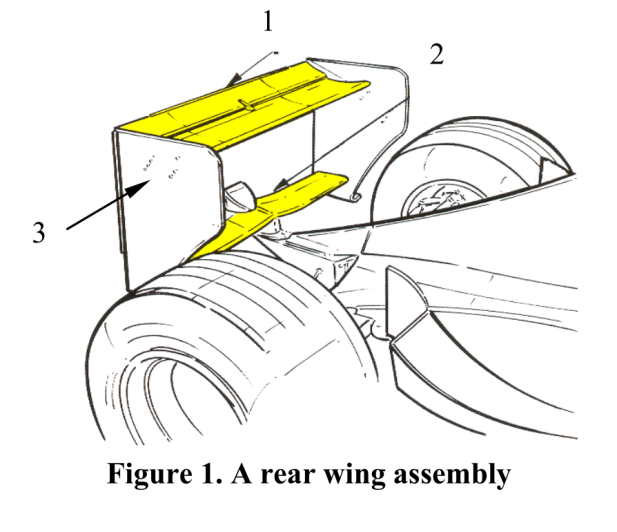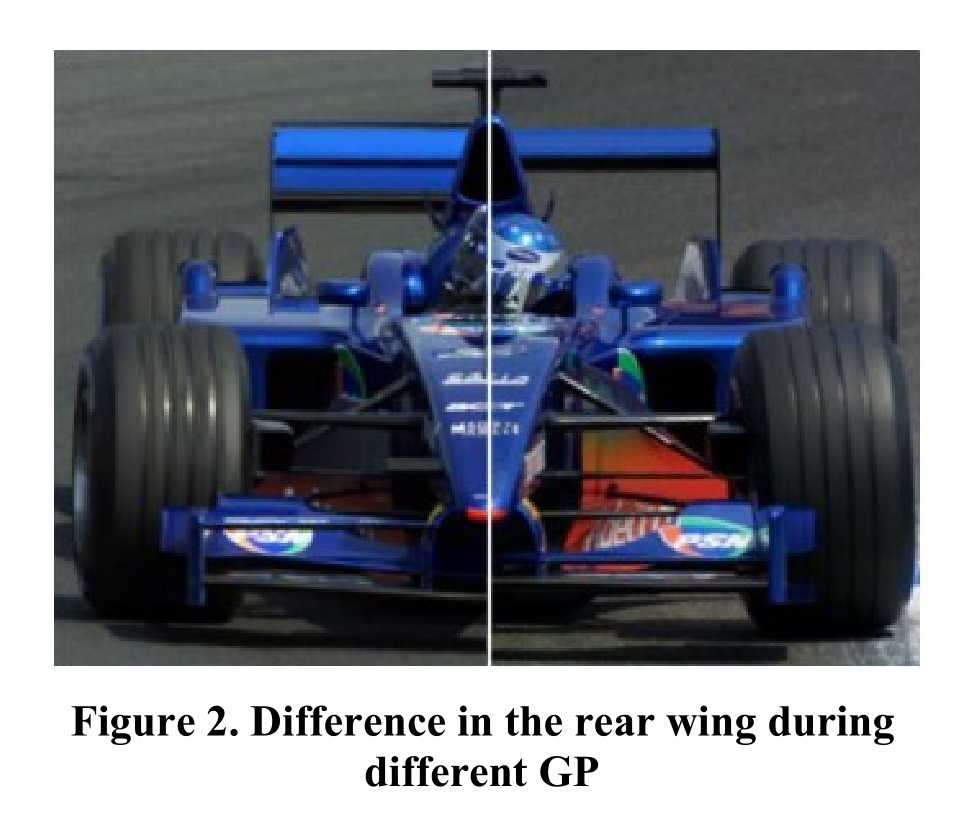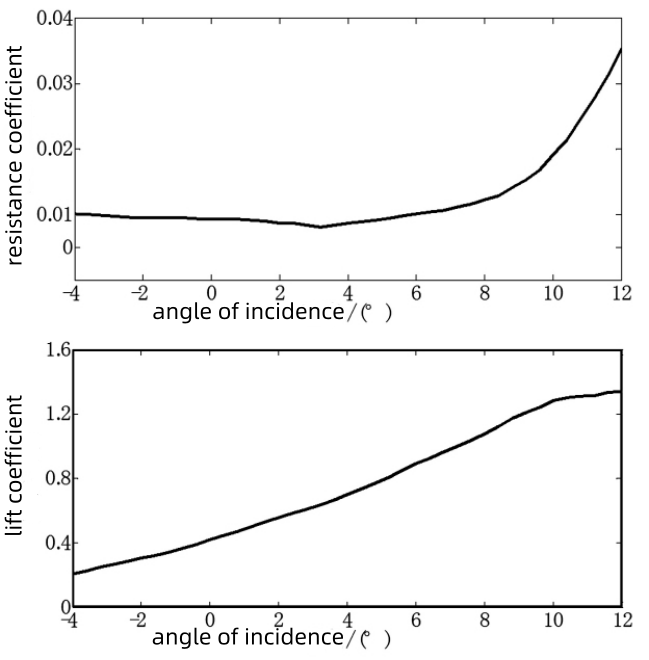1. Introduction
The Formula One (F1) cars are at the forefront of racing technology and innovation. Each team continuously invests a significant amount of time and money in research and development. Many advanced technologies, such as active suspension and energy recovery systems, were initially developed and applied in F1 cars. The Drag Reduction System (DRS) reduces air resistance by adjusting the angle of the rear wing, enabling the following car to achieve a higher speed on the straight track. As a result, it becomes easier for the following car to approach the car in front and complete an overtaking maneuver. This article aims to explore the impact of the DRS on the performance of Formula 1 racing cars, with a particular focus on its effects on speed, maneuverability, and stability. This research not only contributes to the existing body of knowledge in the field of motorsport engineering but also provides valuable insights for teams looking to optimize their vehicle setups. Moreover, the findings have broader implications for the automotive industry, as technologies developed in F1 often trickle down to enhance the performance and efficiency of civilian vehicles.
2. The working principle and application of the drag reduction system
DRS systems are crucial for modern high-speed vehicles, as they can adjust to different driving conditions and optimize the vehicle’s aerodynamic performance [1]. The core component of the Drag Reduction System is an adjustable wing, commonly designated as the DRS flap. The DRS flap can rotate between two positions, one for generating high downforce and the other for generating low drag. When the DRS is activated, the DRS flap rises to reduce the angle of attack, which is the angle between the chord line and the oncoming airflow. This change reduces the downforce generated by the wing surface, thereby reducing air resistance. After the resistance is reduced, the air resistance acting on the car is also decreased, allowing it to achieve a higher speed on straight sections. Racing engineers estimate that the vehicle speed can increase by 10 - 12 km/h (6.2 - 7.5 mph) during the operation of the DRS [2]. It can reduce wind resistance on straight sections to increase vehicle speed, and increase downforce in corners to enhance the vehicle’s cornering performance [3]. Drivers are allowed to activate it under specific conditions, such as within the DRS zones demarcated by the Fédération Internationale de l’Automobile (FIA). These zones are generally set on long straight sections of the track. The purpose is to use the DRS to reduce air resistance, increase vehicle speed, and create overtaking opportunities. The driver presses the overtaking button on the steering wheel to control and adjust the angle of the rear wing through the hydraulic system, changing the aerodynamic characteristics of the racing car during driving, so as to achieve the effect of reducing resistance and increasing speed.
3. Aerodynamic analysis of DRS implementation in Formula 1
3.1. Fundamental principles of aerodynamic resistance
When a vehicle is in motion, the resistances it has to overcome include the resistance caused by mechanical component wear and tear, the rolling resistance (road resistance) generated by the tires, and the air resistance. As the vehicle speed increases, the air resistance gradually becomes the dominant driving resistance. When the speed exceeds 200 km/h, the air resistance accounts for nearly 85% of all the driving resistance. In the high-octane world of Formula One racing, a multitude of factors converge to determine a car’s performance. At present, a significant focus of development lies in enhancing the car’s mechanical grip. Nevertheless, it is widely recognized that aerodynamics plays a critical role in the intricate puzzle of overtaking. Ever since the principles of aerodynamics were integrated into Formula One, their significance in optimizing a car’s performance has been steadily growing [4].
For an F1 car, the ideal aerodynamic state is to generate substantial downforce while minimizing drag. The wings on an F1 car are the powerhouses behind this crucial force. Although they operate on the same fundamental principle as the wings of a conventional aircraft, the application is quite different. Aircraft wings are engineered to produce lift, enabling flight, whereas the wings on an F1 car are positioned in an “inverted” manner. This inversion allows them to generate downforce, firmly pressing the car onto the track surface, which is essential for maintaining high-speed stability and control [5].
3.2. Rear wing design and optimization
3.2.1. Structural composition of rear wing assemblies
The rear wing assembly is a critical component, contributing approximately one-third of the car’s total downforce. This assembly (as depicted in Figure 1) is highly adaptable, with its configuration varying significantly from one track to another. Given that the rear wings are the main source of drag on the car, teams meticulously adjust the rear aerodynamic load to match the unique characteristics of each track.
Take Monza in Italy, for example. It is an extremely fast track featuring long, straight sections and relatively few corners. During a lap, the car operates at full throttle for approximately 70% of the time. As the wing angle increases, more downforce is generated, but this also leads to a significant increase in drag, ultimately reducing the car’s top speed. In such a scenario, where speed is critical, teams opt for a minimal rear wing angle to keep drag to a minimum (as shown in Figure 2 - right).
Conversely, at the Monaco circuit, the situation is quite the opposite. The track is a tight, winding course where the car is constantly maneuvering through corners. Here, downforce is the linchpin of performance. To ensure optimal handling and grip through the corners, the wings need to generate maximum downforce (illustrated in Figure 2 - left).
The rear wing is a complex structure, consisting of two sets of aerofoils connected by wing endplates. The top aerofoil (designated as number 1 in Figure 1) is the primary contributor to downforce and is the most frequently adjusted component depending on the track. Due to the new 2001 regulations, it can now comprise a maximum of three elements. The lower aerofoil (number 2) is smaller and consists of a single element. Besides generating downforce on its own, the low-pressure area directly beneath it plays a crucial role. This area sucks air through the diffuser, augmenting the downforce beneath the car. The endplates (number 3 in Figure 1) serve to connect the two wings and prevent air from escaping over the sides. By doing so, they maximize the high-pressure zone above the wing, thereby generating the maximum possible downforce.

Figure 1: A rear wing assembly [4]

Figure 2: Difference in the rear wing during different GPs [4]
3.2.2. Impact of rear wing angle on aerodynamic performance and track adaptation strategies
To satisfy the downforce demands of racing cars across diverse operating conditions, customized configurations of the rear-wing angle of attack are meticulously devised in accordance with specific operational scenarios.
When the angles of attack of the rear wing are taken as -4°, 0°, 4°, and 8°respectively, Figure 3 shows that the corresponding aerodynamic drag coefficients are 0.01, 0.008, 0.007, and 0.013, and the aerodynamic lift coefficients are 0.22, 0.40, 0.72, and 1.17, respectively.

Figure 3: Lift drag characteristic curves of the rear wing [6]
With the progressive increase in the angle of attack of the rear wing, the lateral displacement of the racing vehicle subjected to crosswind excitation experiences a gradual reduction, thereby leading to a substantial enhancement in the crosswind stability of the racing vehicle [6].
3.3. Aerodynamic balance and vehicle handling
Since the advent of wing-generated aerodynamics in the late 1960s, F1 car performance has been significantly influenced by how closely vehicles can trail one another. Prior to 2014, when engine power was relatively uniform across teams, the minor performance differences meant that teams could not rely on pure engine power to outpace rivals. Instead, the focus shifted to the “dirty air effect”, where the disturbed air from the leading car impacts the following car’s front end, causing unpredictable handling and heightened tire wear due to increased sliding.
The DRS is not merely an “overtake button” that guarantees passing the car ahead. Although there have been instances where its effectiveness led to overtakes well before braking zones on straights, its primary purpose is to facilitate overtaking when drivers would otherwise be trapped in the turbulent, dirty air. The DRS can have a significant impact on a Formula 1 car’s performance. The reduction in drag can increase a car’s top speed by as much as 10 - 15 km/h, depending on the track and the car’s setup [7].
The strategic deployment of the DRS can be a pivotal factor in enabling a driver to close the gap to the preceding vehicle or even achieve an overtaking maneuver. However, the reduction in downforce associated with DRS activation also has a pronounced effect on the vehicle’s handling characteristics, significantly increasing the complexity of maintaining control. This is particularly evident in high-speed scenarios where the aerodynamic balance is critical for vehicle stability. The use of DRS is therefore restricted to specific zones on the track, where the driver is more likely to manage the vehicle’s reduced grip effectively. This limitation is essential to ensure that the driver can maintain control of the vehicle while benefiting from the increased speed provided by the DRS.
Furthermore, the activation of the DRS has a cascading effect on the aerodynamic balance of the vehicle. When the DRS is engaged, the rear wing generates less downforce, necessitating a compensatory increase in downforce production from the front wing. This adjustment is crucial for maintaining overall vehicle stability and preventing aerodynamic imbalance, which could lead to handling difficulties and potential loss of control. The front wing must therefore be meticulously calibrated to provide the necessary downforce to counterbalance the reduced downforce from the rear wing, ensuring that the vehicle remains stable and predictable during high-speed maneuvers.
4. DRS operational challenges
4.1. Technical limitations
Nevertheless, the implementation of the DRS also presents several notable challenges and limitations. DRS increases straight-line speed as it allows air to pass through the rear wing, which means there is less air resistance than normal as the airflow is intentionally redirected upwards [8]. The device is frequently subject to criticism on the grounds that it enables drivers to artificially gain an advantage over their rivals simply by pressing a button to achieve a speed boost. Consequently, it has been argued by some that this detracts from the skill required to successfully execute a challenging overtaking maneuver. While the latest generation of F1 cars has been engineered to facilitate closer following with a diminished “dirty air” effect, many have anticipated that this advancement would render the DRS obsolete. Although the eventual discontinuation of DRS is an objective pursued by F1’s sporting authorities in the coming years, the ongoing utilization of the device remains a matter of contention.
4.2. Competitive concerns
At the same time, car enthusiasts hold different opinions regarding the introduction of the DRS technology. Surveys show that the majority of people believe that the DRS technology can address the issue of insufficient exciting overtakes moments in Formula One races, significantly enhancing the viewing appeal of the competitions. However, others think that this makes overtaking excessively simplified, and drivers of the leading cars do not have an equal opportunity to maintain their positions, as the rules prohibit the leading cars from using DRS for defensive purposes. Nevertheless, in actual races, with the cars traveling at an average speed exceeding 250 km/h, it is quite difficult to determine the optimal timing and opportunities for activating the DRS. For racing drivers, knowing how to utilize the DRS has become a new driving skill. It can be said that mastering the use of DRS enables the vehicle to perform more effectively.
5. Conclusion
This study delves into the impact of DRS technology on the performance of Formula 1 vehicles. In terms of acceleration, DRS effectively reduces aerodynamic drag by altering the angle of the rear wing, thereby significantly enhancing the car’s straight-line speed. This enhancement provides drivers with a favorable condition for overtaking on straights, thereby greatly augmenting the competitiveness and spectacle of the races. In terms of handling, although the reduction in downforce when DRS is activated poses certain challenges, drivers can still achieve efficient control in specific track areas through precise operation and vehicle tuning. Moreover, in terms of stability, when DRS is used judiciously in conjunction with the synergistic effects of other aerodynamic components of the car, it can maintain the stability of the vehicle at high speeds.
However, this study has certain limitations. On the one hand, the research primarily focuses on theoretical analysis of DRS technology and simulation of track data, lacking extensive surveys of drivers’ and teams’ actual usage experiences. This shortfall results in an insufficient understanding of the comprehensive impact of DRS in real race scenarios. On the other hand, there is a lack of in-depth research on the deep integration of DRS with other car systems, such as the energy recovery system and suspension system. As a result, the potential for synergistic optimization of these systems has not been fully explored. In the future, the paper will conduct large-scale questionnaires and interviews targeting drivers and teams to collect first-hand feedback on usage, thereby further refining our understanding of the practical application effects of DRS. Meanwhile, by employing interdisciplinary research methods, researchers will explore the synergistic mechanisms between DRS and other car systems in depth, providing more comprehensive and in-depth theoretical support and technical solutions for the continuous improvement of Formula 1 car performance.
References
[1]. 《Aerodynamic Design of High-Performance Vehicles》 Wolf-Heinrich Hucho Germany Butterworth-Heinemann 2013
[2]. COMSOL. (2024) Modeling Drag Reduction Systems for Motorsports Using CFD. https://cn.comsol.com/blogs/modeling-drag-reduction-systems-for-motorsports-using-cfd
[3]. 《Race Car Engineering and Mechanics》 Paul Van Valkenburgh United States Dodd, Mead & Company 1976
[4]. Smith, J. (2002) Optimum Design of a Formula One Rear Wing Using a Genetic Algorithm. In: International Design Conference - DESIGN 2002. Dubrovnik. pp. 123-135.
[5]. Performance Drivers Club. (2024) DRS in F1. https://performancedriversclub.org/drs-in-f1/
[6]. Ni, J., Wu, Z.C., Chen, S.Z. (2012) Virtual Experiment on the Influence of Rear Wing Angle of Attack on Formula Car Performance. J. Automot. Eng., 2012: 031.
[7]. F1 Chronicle. (2023) How Does DRS Impact Aerodynamics of Formula 1 Car?. https://f1chronicle.com/how-does-drs-impact-aerodynamics-of-formula-1-car/
[8]. Autosport. (2021) What is DRS in F1 and how does it work?. https://www.autosport.com/f1/news/what-is-drs-f1-how-does-it-work/10307184/
Cite this article
Yang,X. (2025). The Impact of Drag Reduction System Technology on the Performance of Formula One Cars. Applied and Computational Engineering,161,11-16.
Data availability
The datasets used and/or analyzed during the current study will be available from the authors upon reasonable request.
Disclaimer/Publisher's Note
The statements, opinions and data contained in all publications are solely those of the individual author(s) and contributor(s) and not of EWA Publishing and/or the editor(s). EWA Publishing and/or the editor(s) disclaim responsibility for any injury to people or property resulting from any ideas, methods, instructions or products referred to in the content.
About volume
Volume title: Proceedings of the 3rd International Conference on Mechatronics and Smart Systems
© 2024 by the author(s). Licensee EWA Publishing, Oxford, UK. This article is an open access article distributed under the terms and
conditions of the Creative Commons Attribution (CC BY) license. Authors who
publish this series agree to the following terms:
1. Authors retain copyright and grant the series right of first publication with the work simultaneously licensed under a Creative Commons
Attribution License that allows others to share the work with an acknowledgment of the work's authorship and initial publication in this
series.
2. Authors are able to enter into separate, additional contractual arrangements for the non-exclusive distribution of the series's published
version of the work (e.g., post it to an institutional repository or publish it in a book), with an acknowledgment of its initial
publication in this series.
3. Authors are permitted and encouraged to post their work online (e.g., in institutional repositories or on their website) prior to and
during the submission process, as it can lead to productive exchanges, as well as earlier and greater citation of published work (See
Open access policy for details).
References
[1]. 《Aerodynamic Design of High-Performance Vehicles》 Wolf-Heinrich Hucho Germany Butterworth-Heinemann 2013
[2]. COMSOL. (2024) Modeling Drag Reduction Systems for Motorsports Using CFD. https://cn.comsol.com/blogs/modeling-drag-reduction-systems-for-motorsports-using-cfd
[3]. 《Race Car Engineering and Mechanics》 Paul Van Valkenburgh United States Dodd, Mead & Company 1976
[4]. Smith, J. (2002) Optimum Design of a Formula One Rear Wing Using a Genetic Algorithm. In: International Design Conference - DESIGN 2002. Dubrovnik. pp. 123-135.
[5]. Performance Drivers Club. (2024) DRS in F1. https://performancedriversclub.org/drs-in-f1/
[6]. Ni, J., Wu, Z.C., Chen, S.Z. (2012) Virtual Experiment on the Influence of Rear Wing Angle of Attack on Formula Car Performance. J. Automot. Eng., 2012: 031.
[7]. F1 Chronicle. (2023) How Does DRS Impact Aerodynamics of Formula 1 Car?. https://f1chronicle.com/how-does-drs-impact-aerodynamics-of-formula-1-car/
[8]. Autosport. (2021) What is DRS in F1 and how does it work?. https://www.autosport.com/f1/news/what-is-drs-f1-how-does-it-work/10307184/









